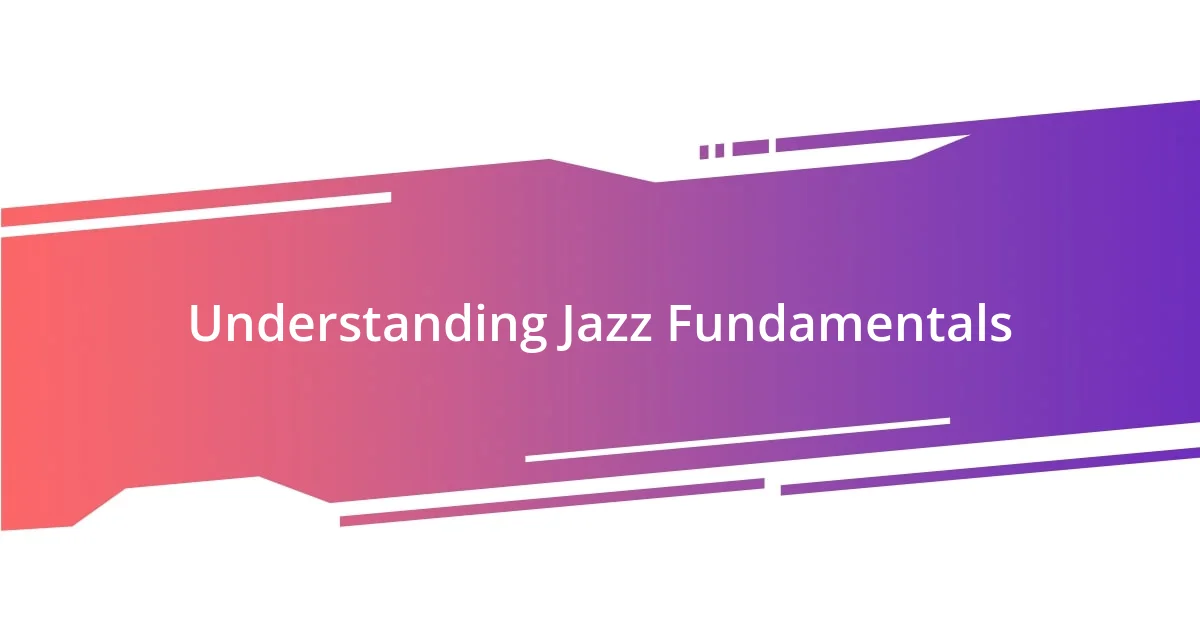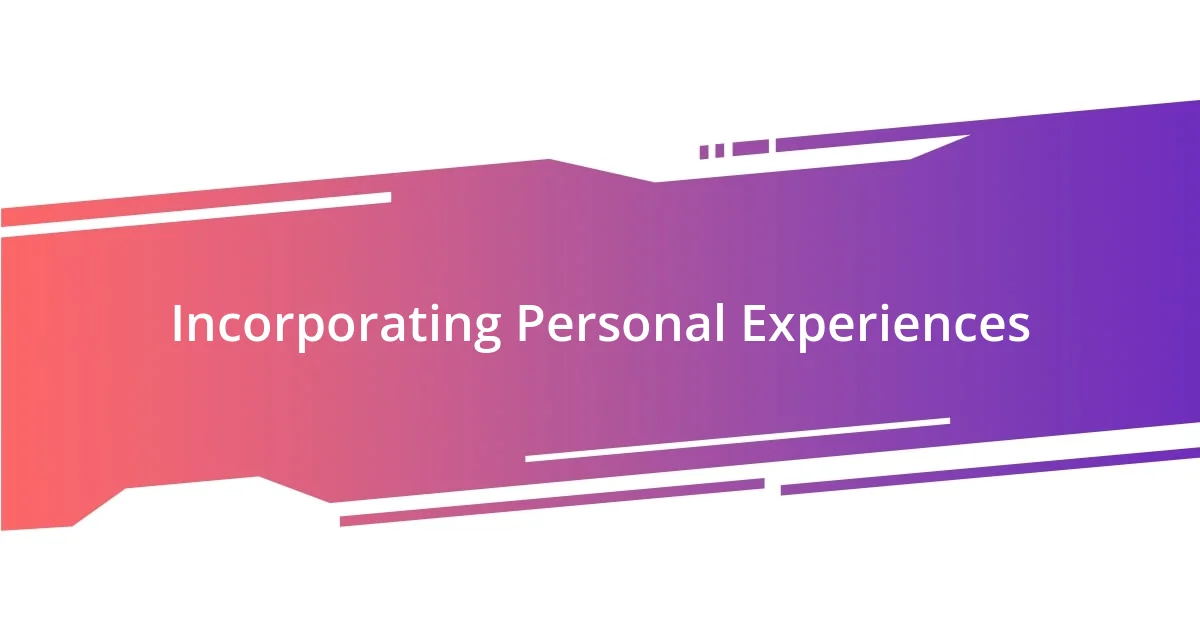Key takeaways:
- Understanding jazz fundamentals—rhythm, harmony, and melody—sets the foundation for personal expression and improvisation.
- Influential jazz artists like Louis Armstrong and John Coltrane inspire musicians to explore their unique sound and storytelling through music.
- Recording practice sessions and evaluating progress fosters growth, highlights areas for improvement, and encourages collaboration with fellow musicians.

Understanding Jazz Fundamentals
To truly grasp the essence of jazz, it’s vital to understand its foundational elements, notably rhythm, harmony, and melody. I still remember the first time I sat in a jazz club, feeling the pulse of the bass reverberate through my body—there was an undeniable connection between the musicians that seemed to rise and fall like a heartbeat. Have you ever felt the difference in energy when a drummer shifts the groove or when a soloist takes a daring flight?
Melody in jazz often takes on a life of its own, transforming with each interpretation. I vividly recall my first attempt at improvisation; I was nervous but exhilarated as I navigated between familiar notes and unexpected leaps. It’s this exploration of improvisation that truly brings jazz alive—every phrase can express joy, sadness, or even nostalgia, inviting listeners into a shared emotional experience.
Harmony forms the backbone of jazz, inviting complexity and depth through chord progressions that can surprise and challenge. When I first delved into standards, I was struck by how a simple chord could shift emotion and mood so profoundly. It often made me wonder: how can the same sequence evoke such different reactions depending on the player’s interpretation? That’s the magic of jazz, and it’s what keeps me constantly inspired to explore my own style.

Exploring Influential Jazz Artists
Diving into the world of jazz, I found myself captivated by the influential artists who have shaped the genre. Artists like Louis Armstrong and Charlie Parker brought a unique flair to their craft, blending technical skill with soul. I still remember the first time I heard Armstrong’s iconic trumpet; it felt like a joyous burst of sunshine that brightened my day. Similarly, Parker’s fast-paced bebop style struck me with its complexity, urging me to push my boundaries as a musician.
Here are some artists that have profoundly influenced my journey in jazz:
- Louis Armstrong: His charismatic trumpet playing and vocal improvisation taught me the power of personal expression.
- Charlie Parker: His innovative approach to melody and harmony inspired me to embrace complexity in my improvisation.
- Billie Holiday: Her emotionally charged performances helped me understand the importance of storytelling in music.
- Miles Davis: His ability to reinvent styles encouraged me to be adventurous and unafraid of change in my own sound.
- John Coltrane: His spiritual approach to music pushed me to explore deeper emotional connections through my playing.
Each of these artists has left an indelible mark on my understanding of jazz, making my personal journey all the more enriching.

Analyzing Different Jazz Styles
The beauty of jazz lies in its diversity, which is evident when analyzing the distinct styles that have evolved over the years. For instance, I remember attending a smooth jazz concert where the fusion of pop elements and melodic improvisation created an atmosphere of relaxation. In contrast, the raw energy of a bebop session left me feeling exhilarated, as complex rhythms and rapid tempos pushed the musicians to their limits—each soloist took flight like a bird breaking free from its cage.
Moreover, examining styles like fusion, which blends jazz with rock and funk, opened up a whole new world for me. I recall my initial exposure to this genre through the music of artists like Weather Report. Their blend of electronic instruments and improvisation transported me to a sonic landscape filled with colors and textures I had never experienced before. It made me question: how can I incorporate such boldness into my own style?
Different jazz styles not only showcase the versatility of musicians but also highlight the improvisational spirit that defines jazz at its core. One pivotal moment for me was when I joined a jam session featuring traditional New Orleans jazz. The call-and-response nature between instruments was mesmerizing, capturing the essence of community in music. Each musician’s interpretation was unique, much like the many paths one can take when developing a personal jazz style.
| Jazz Style | Characteristics |
|---|---|
| Bebop | Fast tempos, complex chord progressions, emphasis on improvisation, often focuses on soloists. |
| Cool Jazz | Relaxed tempos, lighter tones, melodic interplay, and sophisticated harmonies. |
| Fusion | Blends jazz with rock, funk, and world music, featuring electric instruments and diverse rhythms. |
| Traditional New Orleans | Features collective improvisation, laid-back rhythms, and an emphasis on conveying strong emotions. |

Practicing Improvisation Techniques
Practicing improvisation techniques is where the magic truly happens for me. I remember one evening, I set up my saxophone in my living room, determined to play along with some backing tracks. As I experimented with different scales—like the blues scale and the major pentatonic—I felt liberated. It was exhilarating to stumble upon unexpected notes that just clicked. Have you ever experienced that moment when a particular phrase just flows? I often find that the more I embrace those happy accidents, the more my unique style emerges.
Another technique I find instrumental is the use of motifs. I often start with a simple musical idea, repeating and transforming it throughout my improvisation. Once, during a practice session, I took a four-note phrase and played with the rhythm and dynamics until it felt like an emotional rollercoaster. The challenge was not just in the notes, but how I felt while playing them. It made me ask myself: how can I convey a narrative through my music? This transformative process of reshaping motifs has become a cornerstone of my improvisational approach.
Finally, engaging in call-and-response exercises with myself has been incredibly beneficial. I would play a line, then respond to it with a contrasting idea, creating a dialogue within my playing. I distinctly recall a chilly Sunday afternoon when I played along with recordings of great jazz conversations, responding to their phrases as if we were in a musical conversation. This technique not only improved my improvisational fluency but also deepened my emotional connection to the music. Isn’t it fascinating how improvisation can become a personal dialogue, both with oneself and with the world?

Incorporating Personal Experiences
Reflecting on my personal experiences has significantly shaped my jazz style. There was a time when I took a trip to New Orleans, captivated by the vibrant jazz scene. I remember standing in a small club, surrounded by musicians pouring their hearts out on stage. The spontaneity and deep emotional connection they shared inspired me to explore how my own life’s stories could infuse meaning into my playing. Have you ever thought about how your life’s moments—both joyful and challenging—can translate into music? I find that this emotional depth makes each performance uniquely mine.
Sharing stories through my music became a powerful tool. One night, after a particularly challenging week, I decided to express my feelings through my saxophone. Each note I played reflected my struggles and triumphs, creating a heartfelt dialogue with my audience. The intimate atmosphere allowed me to connect deeply, transforming what could have been just a performance into a shared experience. This taught me that every performance is an opportunity to narrate my journey, inviting listeners to join me on that path.
Additionally, I’ve realized the importance of integrating life events into my improvisations. I recall a time I attended a friend’s wedding; the overwhelming love in the room sparked a wave of creativity within me. That evening, my playing felt light and joyful, influenced by the energy of the celebration. As I improvised, I couldn’t help but wonder: how much does the environment and my experiences shape my sound? Embracing these moments enriches my personal jazz journey, allowing my style to grow and evolve consistently.

Developing Unique Musical Identity
Developing a unique musical identity is an exciting journey. For me, it often starts with putting my personal influences front and center. I remember a time when I stumbled upon a dusty old vinyl of Coltrane’s “A Love Supreme.” The first listen struck me with the raw emotion in each note. It made me wonder, what if I let my cultural background and personal struggles seep into my music? That reflection opened doors to blending different genres and infusing my improvisation with rhythmic patterns from the music I grew up listening to.
Another facet that shapes my musical identity is my community. I often jam with local musicians, exchanging ideas and feeding off each other’s energy. Just last week, I played with a guitarist who brought a whole new perspective. He experimented with unexpected chord progressions, and it inspired me to push my boundaries. Have you ever felt a collective vibe in a jam that made you play differently than you usually would? It’s powerful how a single session can leave an imprint on our artistic direction, allowing us to discover new layers of ourselves.
Lastly, I believe vulnerability plays a crucial role. I’ll never forget my first open mic night. The nerves were palpable, yet as I took the stage, I chose to share my insecurities through my piece. My performance echoed my feelings, allowing the audience to connect on a deeper level. This experience taught me that when I embrace my vulnerability and let it guide my sound, I create something that truly reflects who I am. Isn’t it incredible how sharing our authentic selves can lead to a more profound musical identity?

Recording and Evaluating Progress
Recording my practices has become an essential part of my growth. I still remember the first time I set up my phone to capture a session. Listening back was eye-opening; I discovered nuances in my playing that I hadn’t noticed in real-time. Have you experienced that moment when a recording reveals your strengths and weaknesses? It’s like having a mentor right there in your living room.
Evaluating these recordings helps me pinpoint specific areas to improve. I often find myself taking notes as I listen, focusing on everything from articulation to dynamics. One particular session revealed that I rushed through certain passages, which I hadn’t realized while playing. This kind of targeted feedback allows me to set concrete goals for my next practice. I ask myself, how can I refine my phrasing to enhance the storytelling aspect of my music? Each evaluation session becomes an opportunity for self-discovery and growth.
Moreover, I enjoy sharing these recordings with fellow musicians. The feedback I receive not only enhances my understanding but also sparks stimulating conversations about our different approaches. Just the other day, I sent a clip of my latest improvisation to a friend, and surprisingly, his insights opened my eyes to rhythmic patterns I hadn’t explored. Isn’t it fascinating how collaboration can further elevate our personal styles? In this way, evaluating progress transforms from a solitary experience to a communal journey, enriching my artistic expression.















